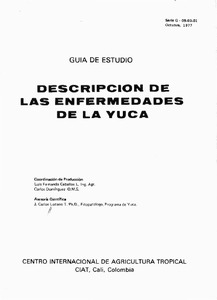Resource information
This audiotutorial unit (cassette, printed script, 93 color slides, Study guide, self-evaluation test), prepared by the Communications Support Unit at CIAT, is available for use with a manually or automatically synchronized slide projector/cassette tape recorder. Each unit is available from the Distribution Office at a cost of US$ 50; photocopies of the study guide alone can be obtained from the Cassava Information Center. One of the main factors limiting to cassava production is disease. More than 30 bacterial, fungal, viral and mycoplasma diseases attack cassava, causing losses in stand and vigor, reduced photosynthetic capacity and root rot. The following diseases are described and illustrated: (a) bacterial - CBB (Xanthomonas manihotis), bacterial stem rot (Erwinia carotovora var. carotovora), bacterial necrosis (Xanthomonas cassavae), stem gall (Agrobacterium tumefaciens); (b) Viral and mycoplasma -AMD, common mosaic, leaf vein mosaic, frog skin, witches'-broom; (c) fungal leaf diseases - brown leaf spot (Cercosporidium henningsii = Cercospora henningsii), leaf blight (Cercospora vicosae), white leaf spot (Phaeoramularia manihotis = Cercospora caribaea), concentric-ring leaf spot (Phoma spp. = Phyllosticta), cassava ash (Oidium manihotis), superelongation (Sphaceloma manihoticola), anthracnose (Glomerella manihotis = Colletotrichum manihotis), rust (Uromyces spp.), Periconia leaf spot (Periconia shyamala); fungal stem diseases -necrosis caused by Glomerella sp. and Botryodiplodia sp. and rot caused by basidiomycetes or ascomycetes; root rots -preharvest. rots caused by Phytophthora drechsleri, Pythium spp., Rosellinia necatrix, Rigidoporus lignosus (equal Fomes lignosus), Armillariella mellea (equal Armillaria mellea), and postharvest rots (microbial and physiological). (CIAT)



